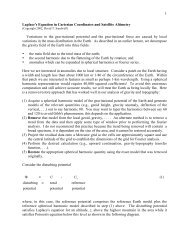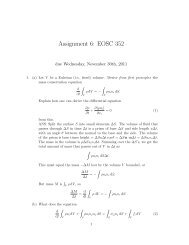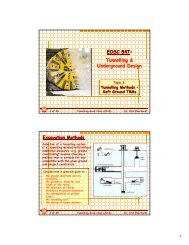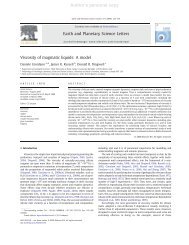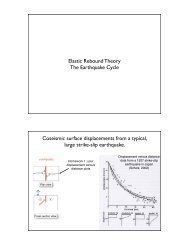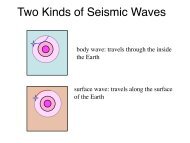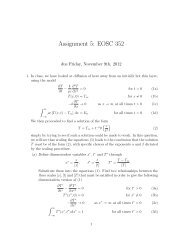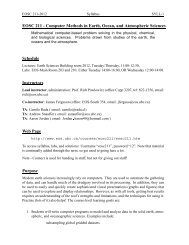P Waves S Waves
P Waves S Waves
P Waves S Waves
You also want an ePaper? Increase the reach of your titles
YUMPU automatically turns print PDFs into web optimized ePapers that Google loves.
Nearly real-time global seismicity from theUSGS National Earthquake InformationCenter (NEIC)Most M > 4 earthquakes worldwidehttp://www.iris.edu/seismon/Monday January 23: Intro to seismic wavesWednesday January 25: seismometryA rockElastic materials store and release elastic energyApply a force(stress)Deformation(strain)Release the force(elastic rebound)The Earth acts like this if strains are tiny and temporary(as in, transmitted disturbances, i.e. seismic waves)If there is too much strain, the rock will either1) deform or flow (plastic or ductile deformation)2) break, or slip along an existing fault (brittle deformation)
• !When an earthquake happens, wheredoes the pent-up elastic energy go?permanent deformation, cracking andpulverizing rock along the fault, generatingheat, and...•! seismic waves, which can travel far from the! earthquake hypocenter (just a tiny % of thetotal energy!)USGSTwo categories of seismic wavesBody waves travel inside materials (the Earth)Surface waves travel along boundaries between materials
P wave (Primary wave)body waves• compression and extension of the solid,like a sound wave• particles move in same direction wavepropagates• fastest type of seismic wave: about 6 km/secondin continental crusthttp://web.ics.purdue.edu/~braile/edumod/waves/WaveDemo.htmLarry BraileS wave (Secondary wave)body waves• shearing distortion of the solid• particles move perpendicular to directionwave propagates• slower than P wave: about 3.5 km/second incontinental crust. Cannot pass through fluids!http://web.ics.purdue.edu/~braile/edumod/waves/WaveDemo.htmLarry Braile
Love wave: horizontalmovement perpendicular towave travel directionsurface waveshttp://web.ics.purdue.edu/~braile/edumod/waves/WaveDemo.htmLarry BraileSeismic Surface <strong>Waves</strong>L, Love waves Transverse horizontalmotion, perpendicular tothe direction ofpropagation and generallyparallel to the Earth’ssurfaceV L ~ 2.0 - 4.5 km/sin the Earthdepending onfrequency of thepropagating waveLove waves exist because of theEarth’s surface. They are largest atthe surface and decrease in amplitudewith depth. Love waves aredispersive, that is, the wave velocity isdependent on frequency, with lowfrequencies normally propagating athigher velocity. Depth of penetrationof the Love waves is also dependenton frequency, with lower frequenciespenetrating to greater depth.R, Rayleighwaves, “Groundroll”Motion is both in thedirection of propagationand perpendicular (in avertical plane).Appearance and particlemotion are similar towater waves.V R ~ 2.0 - 4.5 km/sin the Earthdepending onfrequency of thepropagating waveRayleigh waves are also dispersiveand the amplitudes generally decreasewith depth in the Earth.modified from http://web.ics.purdue.edu/~braile/edumod/waves/WaveDemo.htm
Seismic waves traveling through theEarthhttp://www.youtube.com/watch?v=j86XicBQiGAThis is a ___ wave and it travels_______ the Earth.A) Rayleigh, along the surface ofB) S, along the surface ofC) P, insideD) P, along the surface ofE) S, inside
If an earthquake happens in California, theorder in which the (tiny) seismic wavesarrive here will be:A) P, S, surfaceB) surface, S, PC) S, surface, PD) P, surface, SThe Earthʼs outer core is liquid.Will this wave travel through it?A) NOB) YES
Why doesnʼt this body wave travelthrough the liquid outer core?A) It travels along the Earthʼs surface andwill never even make it to the coreB) It is an S wave and S waves do nottravel through liquidsS-wave “shadow zone” confirms thatthe outer core is liquidmantlePlummer et al., 2004, Fig. 4.9.http://www.youtube.com/watch?v=JQ27PNRe4zA&feature=player_embeddedhttp://www.iris.edu/hq/files/programs/education_and_outreach/aotm/18/4.ShadowZone.swfhttp://whs.moodledo.co.uk/mod/resource/view.php?inpopup=true&id=13624
Frequency: number of waves that pass per second0s1s0s1s12 cycles per second3 cycles per secondWavelength: length of awave in meters (trough totrough or peak to peak)0m300 meters1000mE. HearnFrequency and wavelength are related to wave speedspeed = frequency x wavelengthm/s cycles/s m/cycleMusic: Middle C (in air)- frequency = 261.63 Hz- wavelength = 1.32 m- speed of sound in air = 345 m/s
Seismic waves contain many differentfrequencies jumbled together, but onecan be dominant (Fourier sum)seismogram=scaled, shiftedand added upseismogram: IRISE. HearnSine waves (in a particular place)A(t) =Asin(2πft)ω =2πfsoA(t) =Asin(ωt)If the wave is shifted thenA(t) =Asin(ωt + φ)http://www.doctronics.co.uk/signals.htm
Frequency content? Wavelength?6 kmspeed = frequency x wavelengthAverage P-wave crustal velocity: ~6000 m/s or 6 km/sFrequencies: very broad range, usually 1 to 20 Hz- for 10 Hz waves, wavelength = 600 m- for 1 Hz waves, about 6 kmFrequency content? Wavelength?20 kmSurface wave velocities: ~ 2 km/sFrequencies: lower than body waves (typically .1 to 0.002 Hz)- for 0.1 Hz waves, wavelength = 20 kmAmplitude? Up to a meter at the epicentre, smaller with distanceat 90 degrees away: M3 and M9 = 10 -8 and 10 -2 m(very low frequency for M9: periods of many minutes)speed = frequency x wavelength
Sumatra Earthquake: 26 December 2004These low-frequency waves 16 hours later are still from the same earthquake.Higher sensitivity instruments show that the Earth rang like a gong for days,really long period (low-frequency) waves!How fast do seismic waves travel?Why do the different wave-types travel at different speeds?Speed depends on the material properties1) incompressibility (K)2) rigidity (µ)3) density (!)resistance to volume changeresistance to distortion orbending (=0 for fluids)mass per cubic meterAll of these are related to temperature, pressure, and compositionAs density increases, K andµincrease even more.
V p =P <strong>Waves</strong>√K + 4 3 µρS <strong>Waves</strong>V s =√ µρ<strong>Waves</strong> travel fastest through rigid, hard-to-compress rocks.μ = 0 for fluids: fluids arenʼt rigid. Therefore...S waves do not travel through fluids!Also, P waves are slowed downtraveling through fluids.Surface waves: slower than body waves. Lowestfrequencies travel fastest.•"Like other waves, body wavesrefract and reflectreflection and refraction (bending) at sudden interfaces
• reflection and refraction in continuously changing media• this is why the seismic wave paths are curved...P-wave “shadow zone”: outer core has a slowP-wave velocity so ray paths refract a lot atthe core-mantle boundaryPlummer et al., 2004, Fig. 4.8(20 minutes later)
Reflection of seismic waves from boundaries cancomplicate seismograms recorded far from an earthquaketravel-time datafrom 6000seismogramshttp://www.youtube.com/user/IRISEnO#p/c/8FDF28B8FD0C2E56/3/wSqxDDFZZpM• If we know the travel path, the behaviour of waves can becalculated. (A “forward” problem)Calculations• Can we work backwards? (an “inverse” problem)– Make measurements of time and position …– Can we calculate the travel path to get structure?Inversion?
Reflection tells us where the majorlayers in the Earth are located...Reflection also results in seismic wavesbeing trapped in sedimentary basins...focusshaking is amplified in the basinand trapped (so it reverberatesfor a long time)what is recorded at aseismometer depends on thesource properties, path effects,and local effects (like this).
Seismographs: the basic ideaHeavy mass (shown here withpencil attached) is suspended bya spring.springdampingfluidMSeismograph moves with theground but the mass stays put.Relative motion causes pen totrace ground displacement overtime.Damping fluid stops mass frombouncing around after theground has stopped shaking.GroundVertical seismographhttp://www.youtube.com/watch?v=DX5VXGmdnAg&NR=1Seismographs: the basic ideaPlummer et al., Physical Geology, 2004Vertical seismographhttp://www.youtube.com/watch?v=DX5VXGmdnAg&NR=1
Deploying geophonesnear Williams Lake, BCE. HearnBroadband seismometerinstallations ($$$)IRISIRIS




